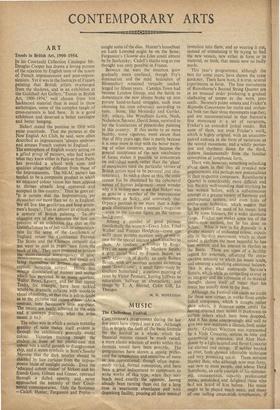MUSIC
CHELTENHAM'S programmes during the last few years have slipped into a rut. Although this is largely the fault of the basic formula for the festival as a whole, which for fina,ncial reasons cannot be much varied, a more elastic selection of works within this formula would have been possible. The programmes have shown a strong prefer- ence for symphonies and concertos of more or less conventional, though often ingeni- ously varied, formal conception, and have been A great inducement to composers to write works of this type, when they very -much need exactly the opposite, having already been turning them out for a long time inw.earisome abundance and with dispiriting facility, pouring all their musical invention into them, and so wearing it out, instead of stimulating it by trying to find the new vessels, new either in form or in material, or both, that music now so badly needs.
This year's programmes, although the best for some years, have shown the same tendency. There have been, it is true, several experiments in form. The four movements of Rawsthorne's Second String Quartet are in an unusual order producing a gradual slackening of tempo as the work pro- ceeds. Stevens's piano sonata and Fricker's Rapsodia Concertante for violin and orches- tra both run their three movements together, and are unconventional in that Stevens's first movement is a set of variations, Fricker's an extended lyrical rondo. But none of them, not even Fricker's work, which is highly original, with an unaccom- panied cadenza in the form of variations as the second movement, and a wildly percus- sive and rhythmic dance for the third, departs fundamentally from the familiar conception of symphonic form.
There was, however, something refreshing about them in that they all revealed new acquirements, and perhaps new potentialities in their respective composers. Rawsthorne's Quartet is considerably more difficult and less fluently well-sounding than anything he has written before, with a self-conscious attempt at a greater variety of harmony and contrapuntal texture, and even h:nts of twelve-note technique, which suggest that he has realised the need of his music, long felt by some listeners, for a wider idiomatic range. Fricker too makes some use or the twelve-note method, but he has done so ,before. What is new in his Rapsodia is a greater mastery of orchestral colour, especi- ally in the-first movement, which as sheer sound is perhaps the most beautiful he has ever written, and his interest in rhythm in the finale. These are signs of a healthy regard for externals, offsetting the intro- spective intensity to wh:ch his music tends, and ensuring a satisfying emotional balance. This is also what commends Stevens's Sonata, wh:ch while as compelling as ever in its integrity and the substance of its musical thought, shows itself off better than his music has usually done in the past.
Although the Festival can claim no credit for these new virtues in works from estab- lished composers, which it accepts rather than selects, it deserves some credit for having retained their names in preference to certain others which have been dropped. And it has done enterprisingly and well to give two new aspirants a chance, both under thirty. Graham Whettam was represented by a Viola Concerto, serious in tone and economical in utterance, and Alun Hod- dinott by a light-hearted and flunnt Concerto for clarinet and strings. If neither bowled us over, both showed admirable technique and very promising talent. There remains Stanley Bate, who although now over forty, was new to most people, and whose Third Symphony, an early exampk of his stimulat- ing, cosmopolitan, superbly profess:onal music, astonished and delighted those who hid not heard of h:m before. His music ought to be played much more, and many of our toiling amateurish Symphonists, if
they must go on writing symphonies, though they will hardly be able to invent such excellent themes, may profit from its accomplishment and its breadth of musical



































 Previous page
Previous page